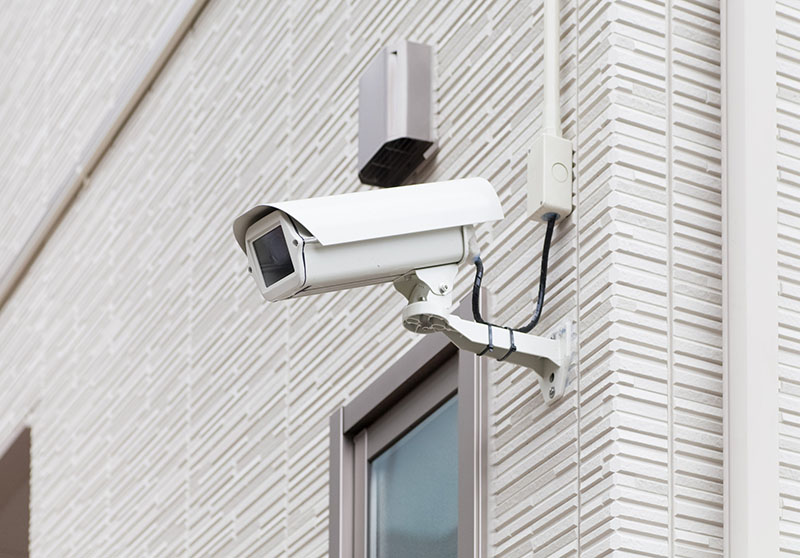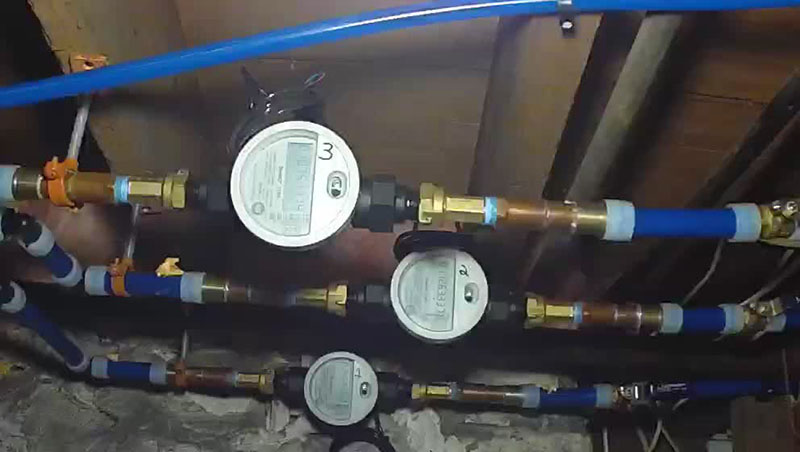Security Cameras Becoming Standard for Rentals
| . Posted in News - 8 Comments
By Eric Weld, MassLandlords, Inc
Security cameras are an exploding industry. Security and surveillance cameras and CCTV (closed circuit television) systems are becoming ubiquitous, used widely among law enforcement agencies, for commercial monitoring and security, and increasingly by governments seeking to surveil whole populaces.

This professionally installed security camera is hard-wired for both power and data transmission using coaxial cable through metal shielding. Image: Licensed 123rf
A substantial part of that market growth is fueled by homeowners and landlords installing cameras on and around their rental buildings. In total, some 42.5 million security cameras were purchased globally in 2020, according to Strategy Analytics. That statistic is expected to reach 120 million this year.
This rapid increase is the result of a convergence of favorable market forces. The cost of security cameras and surveillance gear have trended down in recent years (though inflation and a parts shortage in 2022 have offset – possibly temporarily – that trend). A burst of DIY innovations has simplified installation of security cameras, further reducing costs. Smart technology continues to evolve, introducing ever more options for things that home security systems can do and ways for using them. And of course, crime and public nuisance have not gone away.
All this adds up to a public realm quickly becoming saturated with video surveillance footage, at stores, banks, gas stations, post offices, apartment complex hallways, backyards, driveways and front stoops. And this isn’t even China, where you might assume you are being video surveilled any time you’re in public, especially in a city.
Security Cameras in Retrospect
Surveillance cameras have been around since the 1940s, but it was in 1969 when inventor Marie Van Brittan Brown created the first video-based home security system. Security camera sales got a bump in the 1980s with high crime and lower price tags.
But it was in the late 1990s, when Wi-Fi was introduced, that the industry exploded. Now consumers could live stream their video capture on their computers, then phones and tablets, from anywhere in the world with a signal. Wi-Fi also eliminated the necessity for hardwired systems, leading to DIY innovations. The invention of Bluetooth technology paved the way for another industry boost as cameras entered the Internet of Things realm, equipped for interoperability and smart connectedness.
City, state and national governments have entered the surveillance camera market, too, in a big way. As of 2020, there were more than 770 million cameras in use globally (projected to be more than a billion by 2022), according to an analysis by Comparitech. Most of them are in China.
Security Cameras for Rentals?
For landlords, installing security cameras makes sense on every level.
For daily rental maintenance, a camera system can save landlords time and inconvenience with simple monitoring. Did the landscaper mow the lawn as scheduled? Did the crew you hired clear snow from the egresses? Are your tenants hauling in a couch off the street that is likely filled with bedbugs?
These are a few examples of everyday rental management activities that can be facilitated with security cameras.
A few more examples:
- You know a neighbor’s dog keeps urinating on the bushes on your rental property, but you don’t know which dog is the culprit. Aim the camera at the bushes in question and check the footage after a few days.
- Some tenants are complaining about a party that took place with one particularly loud and foulmouthed guest outside in the wee hours. Check the footage.
- Video footage of one of your rentals shows some 30 people showing up at the door in a week, each staying only for a minute. “Dear Vice Squad, I think there may be drug dealing activity in one of my rentals…”
Security cameras are proven to be an effective way to deter crime and unwanted activity on and around your property. Especially for landlords who live off the premises or a distance away, cameras enable you to monitor comings and goings of tenants and guests. You can also keep track of contractors such as plumbers, electricians and landscapers, and track scheduled deliveries with a record of when they were left on a porch or in the entryway. When crime does occur, surveillance cameras assist law enforcement in pursuing perpetrators. And the presence and knowledge of cameras can provide comfort for tenants and management personnel.
In the long run, security cameras can also save landlords money. The presence of a camera is a discouragement to people considering vandalizing property, saving potential repair and replacement costs. That means fewer insurance claims and lower premiums. For that matter, most insurance companies will offer an outright discount off premium prices for customers who install security cameras.
But for those considering installing security cameras on their rentals, there are a few legal issues to be aware of.
Security Camera Legal Issues
Though Massachusetts has no laws explicitly regulating the use of security cameras, the state does have privacy laws that include the functions of surveillance cameras, such as recording people.
When you install security cameras on and around your rentals, you enter the legal arena of privacy, a hot-button issue. Landlords and property owners have legal rights to install surveillance cameras to help protect their rental properties. But in the United States, citizens also have rights to privacy in their homes and a right to know when they are under surveillance.
That includes inside rental units. Though a rental may be your property as a landlord, you have no right to place surveillance cameras anywhere inside a rental unit’s living or private areas, such as bedrooms and bathrooms.
Any cameras installed should be visible. And it’s advisable to inform tenants that there are security cameras on the premises. A sign or sticker near each camera is sufficient, but a note or verbal notice is even better.
In Massachusetts, you may not legally audio record anyone without their consent, according to MGL c. 272 s. 99, the so-called wiretap law. This is in contrast to most states’ requirements of only one-party knowledge of audio recording. Massachusetts law requires all recorded parties to consent to being recorded.
For video recording, a notice or sign in common areas suffices to inform people that they are being video recorded or surveilled. But in the case of audio, you have to go further than just a sign or notice by receiving their consent to being audio recorded. This is partly because sound can travel around corners and pick up from off-camera, where a disclosure sign isn’t visible. For this reason, most landlords install security cameras around rentals with audio turned off, so that only video is captured – with a clear sign designating the camera’s presence.
Cameras at rentals need to be installed with privacy laws in mind, including MGL c.214, S. 1B, the right of privacy law, and the wiretap law. To be certain you’re within legal compliance when installing cameras on your rentals, consult with an attorney familiar with the state’s privacy laws.
Which Type of Security Camera?
As would be expected within such a burgeoning industry as security cameras, there are many brands, systems and options to choose from. There were an estimated 38 different companies selling surveillance cameras in 2020, according to the security and IoT trade publication asmag.com.
Further complicating purchasing decisions are the many consumer options available among cameras and systems. The earliest, and possibly easiest, decision to make is whether you will install your new security cameras outside, inside or both. Each purpose requires designated devices, the main difference being outdoor cameras’ weather resistance.
Once that decision is made, you’ll need to decide whether you want a wireless (Wi-Fi) system or hardwired, for communicating data; and how to power your camera/s, with batteries or AC. These are both important decisions that we will discuss separately.
Wireless vs. wired transmission
Wireless, or Wi-Fi, cameras refer to those that use a Wi-Fi system to transmit (and sometimes store) their data. A wired camera is connected via either coaxial or Ethernet cable to a digital video recorder (DVR) or a network video recorder (NVR).
Wi-Fi cameras are the more popular option for small home security systems. Wi-Fi cameras are simpler systems, easier to install, more flexible and often easier to operate. These cameras also usually use cloud storage, allowing access to footage from anywhere on a digital device such as your phone. They can also record to an SD card or a base station. Wi-Fi cameras are equipped with motion sensors that activate camera recording only when the sensor is triggered (some can also be set up for constant recording), so as not to waste power on empty footage.
Wired data transmission systems can accommodate more cameras. The cameras are hardwired to the Internet for remote viewing, and may be connected to computer monitors for viewing. They record all activity, 24/7, and usually require professional installation.
Wired systems tend to transmit data more reliably and securely because they rely on a closed transmission system. Image and audio data tend to be higher quality on wired systems with no threat of interfering signals during transmission.
Battery-power vs. AC power
Installing a Wi-Fi (wireless transmission) camera that is battery operated gives you a completely wire-free system, and some marketing would have you believe that’s the simplest, most convenient option. True, a Wi-Fi, battery-operated camera system can be a very simple and quick setup with no need for holes bored in walls to run wires, or affixing cables to run down the side of a building. A wire-free camera also allows more flexibility, as you can easily reposition the camera in different locations as needed.
However, a battery-operated Wi-Fi camera system comes with some caveats.
For one, when you install a battery-operated camera in a high-traffic area (such as an apartment building entrance or near a sidewalk with constant passersby), its motion sensor will be triggered to record everything, draining the battery quickly and needing replacement every few days.
Also, although battery powered, such cameras cannot record when there's no power. The base stations go down and anything the camera sees is not cached for later transmission. It's lost.
Here is an anecdote shared by MassLandlords Executive Director Doug Quattrochi about his frustrating experience with battery-operated cameras on his rental:
Beware of battery-only
“I thought I was saving money with Arlos [Arlo is a popular security camera brand], but in high-traffic areas a full charge lasts only days. Then I installed solar panels and because of the orientation of my house, in winter my high traffic areas only lasted weeks. I spent much more than I bargained for, in time, recharging those damn things. When placed optimally, solar panels allow the Arlos to survive a high-traffic winter. You need to buy these long, long USB cables and then manually trim the weatherstripping off the end of the Arlo male to fit into the Tusita [USB cable brand] female. Having done that, you can have the camera where you need it and the panel on the other side of the house.”
Interior Power
For interior cameras, you will want to consider the correct power source depending on your system. (See above regarding battery-only cameras.) If you’re installing a single IP camera for interior online monitoring, a battery-powered Wi-Fi camera within range of your Wi-Fi router may be sufficient.
If you’re installing more than one camera integrated with other IP devices, it’s recommended to power the system via ethernet using a PoE (Power over Ethernet) switch. PoE provides both power and data transmission. It also provides higher data bandwidth than Wi-Fi, and accommodates ultra HD video.
Other considerations
Among other options: floodlight cameras, equipped with a large floodlight that automatically turns on when the camera does via motion sensor; or doorbell cameras, which are activated when the doorbell is pressed, and include two-way communication via a smart phone or TV.
Security Camera Cost
A security camera system can mean several things, and can range from very simple to complex. The cost of security cameras, as with most things, varies widely depending on the size of your system, the quality of camera you buy, and how many and what kind of bells and whistles you want.
Some landlords might require only a single camera with a phone or tablet app for monitoring footage. Cameras themselves range from $20 to about $400 each (inflation impacts notwithstanding). And with today’s DIY options, a system could be installed for very little money.
SafeHome.org reviewed security cameras for 2022 and concluded that Lorex offers the best overall systems at a reasonable price. Also, Ring, an Amazon-owned company, ranked high for their ease of installation, high definition and inexpensive cloud storage. For the most robust system with high-quality cameras, high resolution and impeccable monitoring, SafeHome recommends ADT, the home security giant.
But the cost of a security camera system must consider factors beyond the camera, depending on the job you want it to do. There are options for professional monitoring, hired installation and storage of recorded footage.
Installation
Most of today’s home security cameras can be DIY installed with minimum knowledge and skills. A wireless system will be easier to install than a hardwired one, but batteries may need replacing occasionally (discussed above). Most cameras come with a video installation guide to spell out the steps, as well as notice stickers to place near the camera. Some even offer over-the-phone installation assistance, and some security companies offer free camera installation with purchase.
It’s always an option to hire a professional camera installer, and larger systems, such as those offered by security giants ADT or Vivent, will require professional installation. Installation costs range roughly between $100 to $200 per camera.
Monitoring
Monitoring security cameras and responding to alarms is a 24/7 process. Few landlords have the time to monitor video footage, most of which is a view of nothing at all. And who would want to?
For that reason, some security companies offer 24/7 monitoring services, in which a team of people are on hand to respond to system alarms when they are tripped. Monitoring costs range from $10 to $50 per month.
Storage
A surveillance camera is of little value without stored footage. In case a crime or unwanted activity takes place on your property, you want the video footage to prove it.
Inexpensive cameras like the Wyze Cam offer free cloud and local storage. Others offer a limited amount of cloud storage options, like Abode cameras that offer three days of storage for free. Most cameras, such as the popular Nest, offer no free storage and will require that added on feature, running between $3 and $10 per month.
Recent improvements
Home security and surveillance cameras are a fast-moving industry. With cloud technology and interoperability, security cameras have become a component within smart home systems, tied in with overall security, computers, phones and other devices with remote operation.
This technological sophistication has widened the range of security system functionality, from simple single-camera systems with cloud monitoring to multi-camera systems interconnected with door locks, motion sensors, lights, sirens and thermostats. All these IP devices can communicate through an integrated Wi-Fi network for maximum efficiency and convenience.

When buying a camera for uses such as monitoring electric or water meters, research resolution specs thoroughly beyond marketing promises. This image, captured by a topline Arlo camera with high definition, is barely legible. Image: cc by-sa 4.0 MassLandlords.
Image quality
As with photography, video image technology continues to expand. Today’s cameras, using larger sensors and lenses, see further with better clarity, even in non-ideal lighting environments.
This technological advancement is essential for the efficacy of surveillance cameras. It allows users and law enforcement forensic investigators to isolate, zoom in and enlarge faces, numbers and details to help identify people and collect evidence of their activities on the property.
And with the intelligence of advanced compression and decompression encoders (codecs), data-heavy images can be stored and shared much more easily than only a few years ago.
That said, some cameras, such as those made by Arlo, may not provide the resolution needed to capture detailed images such as license plates, electric meters and water meters. Though most cameras promote the ability to pick up meter readings and transmit them to a remote Wi-Fi device, the reality is that, even with high definition cameras and plans, resolution may not be sharp enough to capture meter readings legibly even at close range with abundant light.
This compromise with image fidelity also comes into play in crime prevention and pursuit of perpetrators. For a camera to be useful in crime management, it must be able to pick up the details of a license plate from 100 feet away. Most consumer devices do not have that ability.
Search capabilities
Gone are the days when you had to pore through every second of video footage in order to find a given moment of action. Two recent search innovations have sped up the process.
Basic description technology allows users to type in visual descriptive details in order to immediately locate all footage that includes those details. Now you can enter “red hat, green pants” and all frames including those characteristics – people in the video footage wearing a red hat and green pants – will appear on the screen for closer scrutiny. Search for “FedEx trucks,” “dark hair,” or similar visual details to quickly find pertinent footage.
The other relatively recent innovation is facial recognition (part of the menu of biometrics detection options including fingerprints, eyes, palms and voice recognition). This technology allows a camera to identify faces and other biometric details that appear in footage and store that data in a bank for later retrieval. If a face or identity appears later on in your footage that is not recognized as part of your footage memory bank, it will assist in narrowing your search.
Face recognition technology is controversial for its infringement on privacy, and has been banned for use by police and municipal agencies in Boston, San Francisco and several other cities. Another reason for the ban is that facial recognition reinforces racial bias because testing algorithms emphasize white male subjects many times more than Black and brown and female subjects. This discrepancy results in a much poorer identification accuracy rate among Black, female and younger subjects.
More recent upgrades
In addition to incorporating the latest technologies, home security cameras have also made improvements and simplifications in many areas: DIY, allowing more consumers to install systems themselves and significantly save on cost; voice-controlled capabilities, adding convenience and enhanced remote command options; and improved network security, a necessity when operating numerous devices on one integrated system.
Specialty and novel features
In addition to practical considerations, a number of cameras have entered the market catering to people’s special needs. For example, there are now cameras that allow you to hear, talk and play with your pet from a remote location. You can even toss them treats. Pet cameras can also be set to alert you when your pet is barking or meowing.
There are also sophisticated cameras for monitoring babies that can record temperature, humidity and air quality in the baby’s room, and allow two-way communication.
Which Brand of Security Camera?
Choosing a camera brand will depend on what you want it to do, how much you want to spend and other factors.
There are benefits to going with more popular brands – they are more market-tested, and likely easier to repair when necessary – and advantages with lesser known brands – sometimes less expensive.
Often, the most widely sold brands gain that status because their quality is proven on the market. Among the top-selling home security camera brands, according to SafeHome.org, are those made by Ring, Arlo, Blink, Wyze, Nest (Google) and Lorex. MassLandlords members have recommended UniFi and Hikvision brand cameras for the next level above popular consumer brands.
Security vs. Privacy
The day seems not far off when security and surveillance cameras will be a ubiquitous and accepted facet of our daily lives, as they now are in some countries. The industry is growing rapidly and prices are becoming very competitive. The service and security provided by cameras makes them nearly a must-buy for landlords to protect their property.
For the cultural moment, concerns for security and protection seem to override questions of privacy and its erosion, though Massachusetts retains laws to protect people’s individual privacy. It’s still illegal, for example, to audio record someone in this state without their consent. And while public spaces and even home exteriors in view from a public area such as a street are open for video surveillance, you are on legally thin ground if you point a camera toward the window of a private space such as a bedroom or bathroom. And if you plan to fly a drone equipped with a camera over private land, you’d be wise to check local ordinances first. Some municipalities, such as Chicopee, require permission of the property owner for drone operation on their land.
It will be up to us as a society to decide how much privacy we want to forfeit for the increasing emphasis on safety, security and surveillance. For now, security cameras are trending the way of the door lock in quickly becoming a standard tool for protecting and monitoring rental properties.
More Information on Security Cameras
MassLandlords has hosted events with several security camera experts in recent years. Click links below to view informative videos and articles about security systems.
- Chris Yacino, 2015, on general benefits of surveillance systems;
- Charles Hadsell, 2019, on smart home technologies;
- RJ Horwitz, 2015, perspectives on security;
- Patrick Sullivan, presentation on security cameras and systems
- Article on the risks of recording audio via cameras;
- Article on high-tech crime fighting, including security cameras, in Worcester.




